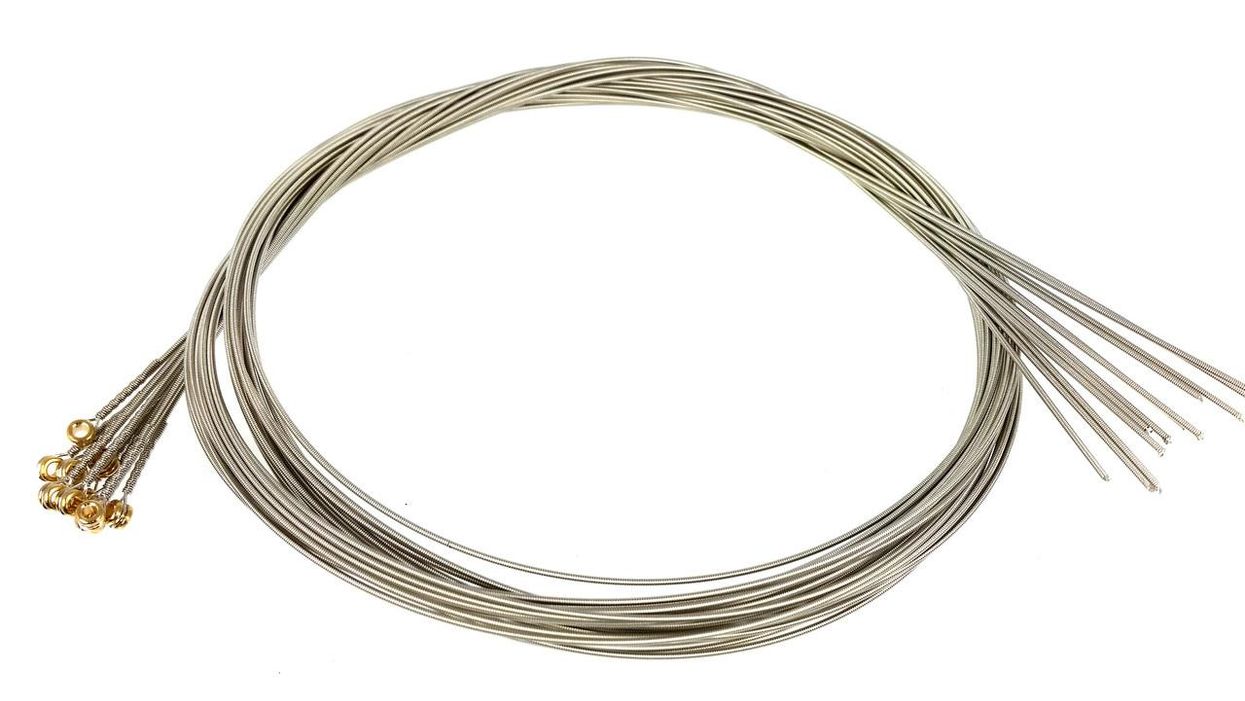Stevie Ray Vaughan's influence on gear and gearheads has been gigantic. Back in the '80s, it seemed as if he almost single-handedly resurrected the Stratocaster, helping boost vintage Strats into a mythic realm. And who else did more to bring the worship of vintage Fender amps to a whole new level?
In one of his earliest major interviews, around 1983, Stevie Ray Vaughan let out a bit of personal information that has had an effect on gear and gearheads to this day. Talking about his now well-known '59 Strat—even then completely trashed—he told the interviewer what string gauges he was using: .013 to .052. The interviewer was surprised and asked him to repeat it. Yep, 13s. I remember reading that interview as a teenager and my jaw dropping.
No one used strings that thick. But now that Stevie Ray did, it started to creep into the consciousness. Thus became the mantra, myth, truth, cliché—whatever you want to call it—in strings: heavier is better. Surely, heavy strings produce better tone. And, surely, only a great player will be able to handle the thicks. So, it follows that if I play heavy strings I am great. The debate goes on. You hear it all the time. "Anybody tried 12s?"
Some myths are meant to be explored, so let's look at some of the great players and the gauge strings they used. Starting with Stevie Ray, we find that, according to most available published information, he did indeed play some of the heaviest gauges available, most consistently 13s. He even went thicker, an astounding .018-.072 at one point. However, on the brown '63 Strat known as Lenny, SRV switched to lighter strings to get a lighter tone. Some nights when his fingers were thrashed he'd go down as light as 11s—back into mere mortal territory. It was rumored that he went to lighter strings later in his life, but I haven't been able to substantiate this.
Swing to another god of guitar, James Marshall Hendrix, undisputed King of Gigantic Tone. One might assume that from gigantic strings come gigantic tone, but check this little tidbit from the absolute must-have book Jimi Hendrix: Musician by Keith Shadwick: "Hendrix described the setup on his Strat around 1967 as 'Fender light-gauge strings, using a regular E-string for the B and sometimes a tenor A-string for a [high] E to get my kind of sound on the Stratocaster. [I] put the strings on with a slightly higher [action] so they can ring longer.' This particular string-swapping routine was a popular modification at the time. It resulted in a set of stings as light as possible, aiding not only the string bending but also finger vibrato. On a later guitar, his black Strat, the surviving strings indicate he preferred 'light' gauges, .009" to .038"."
Now go back to the roots. Early on in rock history, flatwounds were all there were. It wasn't until 1959 when Ernie Ball put together his first sets that you could get some medium or light-gauge strings. Here's another mind- blower: until guys like Ernie Ball came around, aspiring string-benders like Chuck Berry found a secret weapon—banjo strings. Yes, that ultimate rock tone that Chuck Berry got on songs like "Johnny B. Goode," "School Days," and "Sweet Little 16" was derived from 8-gauge or lower banjo strings.
Some more:
- Jimmy Page: well-known user of 8-gauge strings.
- Danny Gatton: played 10s with a wound G, also played 9s.
- Jeff Beck: "On my early stuff, I was playing the thinnest strings you could get, .008s," Beck told Fender.com. "And then the Jimi man came along and told me, 'You can't play with those rubber bands. Get those off there.' So my string gauges have been creeping up ever since. Now I've got .011, .013, .017, .028, .038, and .049. I'm trying to get heavier on the top end."
- Billy Gibbons: hipped to light-gauge 8s or 9s by B.B. King. King's take on it is that it takes a lot less stress and strain to play the light stuff. Gibbons' custom set from Dunlop has a 7-gauge high E!
- Brian Setzer: 10s straight out of the box.
- Peter Frampton: 8s back in the Comes Alive days.
- Carlos Santana: 9s
- Allan Holdsworth: 11s
- Eddie Van Halen: well-known for using 9-gauge.
- James Hetfield: .009-.042
As you can see, a lot of the great players of our time have used some pretty everyday-player gauges. This is not to say that heavy strings don't produce a different tone. The point is that the gauge of your strings is not the gauge of your greatness.
Back in the '80s when I read that SRV interview, I immediately went out and got a set of 13s put on my yellow '79 hardtail Strat. The guy at the store looked at me oddly, wondering what I was up to. What I was up to was sticking my nose where it didn't belong. What I failed to remember was that Stevie Ray was a pro playing at a pro level. He played gigs every night for years to get to the point where he needed 13s. Needed, not wanted. Because of the style he had developed and the level he was playing at, SRV had to have those strings to get through the gig. Other strings would break under the strain and not produce the tonal heights he was looking for. Me? I was just a kid playing in my bedroom. When I got the Strat home with the 13s on it, I plugged it into my Peavey Classic 2x12 and tried—really tried— to play "Love Struck Baby." Didn't happen. I could barely chord with those monsters, let alone bend. Lesson learned.
[Updated 7/29/21]












![Rig Rundown: Russian Circles’ Mike Sullivan [2025]](https://www.premierguitar.com/media-library/youtube.jpg?id=62303631&width=1245&height=700&quality=70&coordinates=0%2C0%2C0%2C0)






